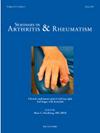Incidence of gout diagnosis among participants with hyperuricemia, insights from a nationwide cohort study
IF 4.4
2区 医学
Q1 RHEUMATOLOGY
引用次数: 0
Abstract
Objectives
To examine the relationship between serum urate (SU) levels in hyperuricemic participants and the risk of developing gout.
Methods
A retrospective nationwide Israeli cohort study used the Clalit Health Insurance database of 473,124 individuals to identify adults aged 16 or older with at least two SU measurements exceeding 6.8 mg/dL between January 2007 and December 2022. Participants with a prior gout diagnosis or on gout medications were excluded. The primary outcome was a gout diagnosis, at least 90 days after the second record of hyperuricemia. Individuals were divided into four quartiles according to their second SU level. Survival analysis using Cox proportional hazards regression was conducted to evaluate the incidence of gout across SU quartiles.
Results
301,385 participants were defined as having hyperuricemia, of whom 15,055 (5 %) were diagnosed with gout after the index date. The mean/median of the second SU level of each quartile was 6.95/6.96 mg/dL, 7.20/7.20 mg/dL, 7.58/7.60 mg/dL, and 8.62/8.38 mg/dL, respectively. Participants with hyperuricemia from the highest SU quartile showed the steepest linear decline rate of gout-free survival (log-rank test P-value<0.0001). Thirteen percent (13 %) of participants in the highest SU quartile developed gout over 10 years, also showing a steady annual incidence rate of gout of 1.3 % (in that fourth quartile).
Conclusion
Among participants with hyperuricemia, SU level stands out as the most important risk factor associated with significant increase in the incidence of gout.
痛风诊断在高尿酸血症参与者中的发病率,来自全国队列研究的见解
目的探讨高尿酸血症患者血清尿酸(SU)水平与痛风发生风险的关系。方法一项回顾性以色列全国队列研究使用Clalit健康保险数据库的473,124人,以确定2007年1月至2022年12月期间至少有两次SU测量值超过6.8 mg/dL的16岁或以上的成年人。先前有痛风诊断或正在服用痛风药物的参与者被排除在外。主要结局是痛风诊断,在第二次高尿酸血症记录后至少90天。根据个体的二级SU水平,将个体分为四个四分位数。使用Cox比例风险回归进行生存分析,以评估整个SU四分位数的痛风发生率。结果301385名参与者被定义为高尿酸血症,其中15055人(5%)在指数日期后被诊断为痛风。每个四分位数的第二级SU水平的平均值/中位数分别为6.95/6.96 mg/dL、7.20/7.20 mg/dL、7.58/7.60 mg/dL和8.62/8.38 mg/dL。SU最高四分位数的高尿酸血症患者无痛风生存的线性下降率最大(log-rank检验p值为0.0001)。在SU最高的四分位数中,有13%的参与者在10年内患上了痛风,并且痛风的年发病率稳定在1.3%(在第四四分位数中)。结论在高尿酸血症患者中,尿酸水平是痛风发生率显著增加的最重要危险因素。
本文章由计算机程序翻译,如有差异,请以英文原文为准。
求助全文
约1分钟内获得全文
求助全文
来源期刊
CiteScore
9.20
自引率
4.00%
发文量
176
审稿时长
46 days
期刊介绍:
Seminars in Arthritis and Rheumatism provides access to the highest-quality clinical, therapeutic and translational research about arthritis, rheumatology and musculoskeletal disorders that affect the joints and connective tissue. Each bimonthly issue includes articles giving you the latest diagnostic criteria, consensus statements, systematic reviews and meta-analyses as well as clinical and translational research studies. Read this journal for the latest groundbreaking research and to gain insights from scientists and clinicians on the management and treatment of musculoskeletal and autoimmune rheumatologic diseases. The journal is of interest to rheumatologists, orthopedic surgeons, internal medicine physicians, immunologists and specialists in bone and mineral metabolism.

 求助内容:
求助内容: 应助结果提醒方式:
应助结果提醒方式:


